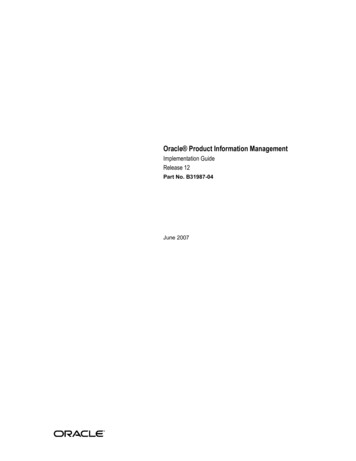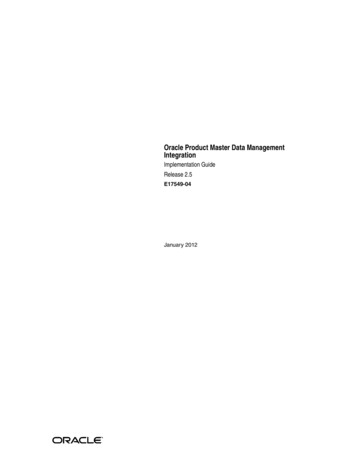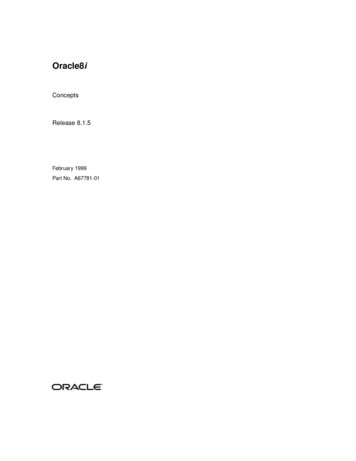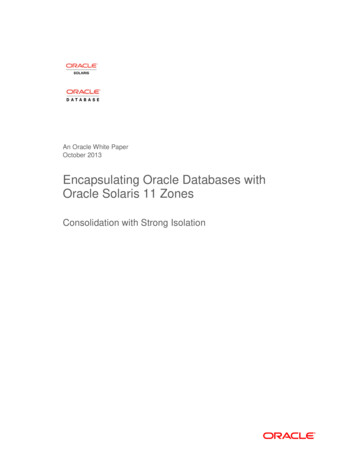
Transcription
Oracle Product Information ManagementImplementation GuideRelease 12Part No. B31987-04June 2007
Oracle Product Information Management Implementation Guide, Release 12Part No. B31987-04Copyright 1995, 2007, Oracle. All rights reserved.Primary Author:Laurel DaleContributing Author:Jim Aliferis, Steven Cascio, Kunal Desai, Anu Mandalam, Sandeep SoodThe Programs (which include both the software and documentation) contain proprietary information; theyare provided under a license agreement containing restrictions on use and disclosure and are also protectedby copyright, patent, and other intellectual and industrial property laws. Reverse engineering, disassembly, ordecompilation of the Programs, except to the extent required to obtain interoperability with otherindependently created software or as specified by law, is prohibited.The information contained in this document is subject to change without notice. If you find any problems inthe documentation, please report them to us in writing. This document is not warranted to be error-free.Except as may be expressly permitted in your license agreement for these Programs, no part of thesePrograms may be reproduced or transmitted in any form or by any means, electronic or mechanical, for anypurpose.If the Programs are delivered to the United States Government or anyone licensing or using the Programs onbehalf of the United States Government, the following notice is applicable:U.S. GOVERNMENT RIGHTSPrograms, software, databases, and related documentation and technical data delivered to U.S. Governmentcustomers are "commercial computer software" or "commercial technical data" pursuant to the applicableFederal Acquisition Regulation and agency-specific supplemental regulations. As such, use, duplication,disclosure, modification, and adaptation of the Programs, including documentation and technical data, shallbe subject to the licensing restrictions set forth in the applicable Oracle license agreement, and, to the extentapplicable, the additional rights set forth in FAR 52.227-19, Commercial Computer Software--RestrictedRights (June 1987). Oracle Corporation, 500 Oracle Parkway, Redwood City, CA 94065.The Programs are not intended for use in any nuclear, aviation, mass transit, medical, or other inherentlydangerous applications. It shall be the licensee's responsibility to take all appropriate fail-safe, backup,redundancy and other measures to ensure the safe use of such applications if the Programs are used for suchpurposes, and we disclaim liability for any damages caused by such use of the Programs.The Programs may provide links to Web sites and access to content, products, and services from third parties.Oracle is not responsible for the availability of, or any content provided on, third-party Web sites. You bear allrisks associated with the use of such content. If you choose to purchase any products or services from a thirdparty, the relationship is directly between you and the third party. Oracle is not responsible for: (a) the qualityof third-party products or services; or (b) fulfilling any of the terms of the agreement with the third party,including delivery of products or services and warranty obligations related to purchased products or services.Oracle is not responsible for any loss or damage of any sort that you may incur from dealing with any thirdparty.Oracle, JD Edwards, PeopleSoft, and Siebel are registered trademarks of Oracle Corporation and/or itsaffiliates. Other names may be trademarks of their respective owners.
ContentsSend Us Your CommentsPreface1License for Oracle Product Hub and Oracle Product Hub Data StewardLicense. 1-12Implementation OverviewSet Up Oracle Applications Technology. 2-1Setup Prerequisites. 2-1Using Oracle iSetup. 2-2Setup Steps. 2-3Profile Options. 2-33Defining Responsibilities and UsersDefining Responsibilities and Users. 3-1Creating Responsibilities. 3-1Creating Internal Users. 3-4Setting Up Supplier Users. 3-5Setting Up Customer Users. 3-54Defining the Item CatalogOverview of Item Catalogs.4-2Build the Item Catalog Text Index. 4-3Defining Item Catalog Categories. 4-3Defining Value Sets for User-Defined Attributes.4-4iii
Defining Item Attributes and Attribute Groups. 4-8Defining Attribute Usages . 4-11Display Attachments on Item Attribute Pages. 4-13Setting Up Item Attribute Group Security. 4-15Implementing User-Defined Functions for Item Attributes. 4-18Associating Item Catalog Attributes. 4-22Defining Item Attachment Categories. 4-24Associating Item Attachment Categories.4-25Setting Up Item Templates. 4-25Defining Lifecycle Phases. 4-27Defining Lifecycles. 4-29Associating Lifecycles to Item Catalog Categories. 4-30Defining Change Policies. 4-31Defining New Item Request Types. 4-32Defining New Item Request Workflows. 4-34Setting Up New Item Request for an Item Catalog Category. 4-34Defining Item Number and Description Generation Rules. 4-36Defining Item Catalog Search Criteria. 4-38Defining Item Catalog Display Formats. 4-39Defining Item Catalog Import Formats. 4-39Defining Report Templates Using XML Publisher . 4-40Defining Cross Reference Types. 4-425Defining CatalogsOverview of Catalogs. 5-1Defining Catalog Categories. 5-3Defining Catalogs. 5-4Implementing Catalog Security. 5-46Defining Change Categories and TypesOverview of Change Categories and Types. 6-2Build the Change Management Text Index. 6-3Defining Change Categories. 6-3Creating Priority Codes . 6-8Creating Reason Codes . 6-9Creating Classification Codes. 6-9Creating Statuses. 6-9Defining Workflow Templates. 6-10Attaching Workflow Templates. 6-12Customizing Change Management Workflows. 6-13iv
Creating Task Templates. 6-14Defining Header/Line Type Attributes and Attribute Groups. 6-15Defining Header Types. 6-18Defining Line Types . 6-21Associating Change Type Attributes. 6-23Associating Change Line Type Attributes. 6-24Setting Up Change Attribute Group Security. 6-24Implementing User Defined Functions for Change Type Attribute. 6-25Defining Change Category Search Criteria. 6-28Defining Change Category Display Formats. 6-28Defining Change Category Reports. 6-297Defining Item StructuresOverview of Item Structures. 7-1Defining Structures. 7-2Display Formats and Search Criteria for Structures.7-4User Defined Attributes for Structures and Components. 7-5Valid Component Type Rules. 7-68Setting Up Content Management RepositoriesIntegrating Oracle E-Business Suite Applications with Content Management Repositories. 8-1Setting Up a Content Management Repository. 8-49Setting Up E-Business Suite AttachmentsOverview of E-Business Suite Attachments. 9-1Structuring Folders. 9-1Attachment Review and Approval.9-3Change Management for Attachments. 9-510Defining RolesOverview of Roles. 10-1Defining Roles. 10-211Implementing Role Based SecurityOverview Role Based Security. 11-1Defining Role Based Security. 11-1v
12Understanding Product Data SynchronizationOverview of Product Data Synchronization. 12-1Overview of Global Data Synchronization Network and 1SYNC.12-2Global Data Synchronization Network. 12-3Managing Global Trade Item Number Information. 12-12Oracle 1SYNC Registry Messages.12-13Support 1SYNC Supplier Synchronization Suite. 12-15Notification Processing. 12-17Publish the Registered Information to Trading Partners.12-19AWorkflows for Change and Document ManagementWorkflows for Change and Document Management. A-1BItem Business EventsBusiness Events. B-1CReading Data for User-Defined AttributesOverview. C-1DSynchronizing Item User-Defined Attributes with Item Descriptive ElementsOverview. D-1EChange Management Business EventsDescription of Change Management Business Events. E-1Indexvi
Send Us Your CommentsOracle Product Information Management Implementation Guide, Release 12Part No. B31987-04Oracle welcomes customers' comments and suggestions on the quality and usefulness of this document.Your feedback is important, and helps us to best meet your needs as a user of our products. For example: Are the implementation steps correct and complete?Did you understand the context of the procedures?Did you find any errors in the information?Does the structure of the information help you with your tasks?Do you need different information or graphics? If so, where, and in what format?Are the examples correct? Do you need more examples?If you find any errors or have any other suggestions for improvement, then please tell us your name, thename of the company who has licensed our products, the title and part number of the documentation andthe chapter, section, and page number (if available).Note: Before sending us your comments, you might like to check that you have the latest version of thedocument and if any concerns are already addressed. To do this, access the new Applications ReleaseOnline Documentation CD available on Oracle MetaLink and www.oracle.com. It contains the mostcurrent Documentation Library plus all documents revised or released recently.Send your comments to us using the electronic mail address: appsdoc us@oracle.comPlease give your name, address, electronic mail address, and telephone number (optional).If you need assistance with Oracle software, then please contact your support representative or OracleSupport Services.If you require training or instruction in using Oracle software, then please contact your Oracle local officeand inquire about our Oracle University offerings. A list of Oracle offices is available on our Web site atwww.oracle.com.vii
PrefaceIntended AudienceWelcome to Release 12 of the Oracle Product Information Management ImplementationGuide.See Related Information Sources on page x for more Oracle Applications productinformation.TTY Access to Oracle Support ServicesOracle provides dedicated Text Telephone (TTY) access to Oracle Support Serviceswithin the United States of America 24 hours a day, seven days a week. For TTYsupport, call 800.446.2398.Documentation AccessibilityOur goal is to make Oracle products, services, and supporting documentationaccessible, with good usability, to the disabled community. To that end, ourdocumentation includes features that make information available to users of assistivetechnology. This documentation is available in HTML format, and contains markup tofacilitate access by the disabled community. Accessibility standards will continue toevolve over time, and Oracle is actively engaged with other market-leading technologyvendors to address technical obstacles so that our documentation can be accessible to allof our customers. For more information, visit the Oracle Accessibility Program Web siteat http://www.oracle.com/accessibility/ .Accessibility of Code Examples in DocumentationScreen readers may not always correctly read the code examples in this document. Theconventions for writing code require that closing braces should appear on an otherwiseempty line; however, some screen readers may not always read a line of text thatix
consists solely of a bracket or brace.Accessibility of Links to External Web Sites in DocumentationThis documentation may contain links to Web sites of other companies or organizationsthat Oracle does not own or control. Oracle neither evaluates nor makes anyrepresentations regarding the accessibility of these Web sites.Structure1 License for Oracle Product Hub and Oracle Product Hub Data Steward2 Implementation Overview3 Defining Responsibilities and Users4 Defining the Item Catalog5 Defining Catalogs6 Defining Change Categories and Types7 Defining Item Structures8 Setting Up Content Management Repositories9 Setting Up E-Business Suite Attachments10 Defining Roles11 Implementing Role Based Security12 Understanding Product Data SynchronizationA Workflows for Change and Document ManagementB Item Business EventsC Reading Data for User-Defined AttributesD Synchronizing Item User-Defined Attributes with Item Descriptive ElementsE Change Management Business EventsRelated Information SourcesIntegration RepositoryThe Oracle Integration Repository is a compilation of information about the serviceendpoints exposed by the Oracle E-Business Suite of applications. It provides acomplete catalog of Oracle E-Business Suite's business service interfaces. The tool letsusers easily discover and deploy the appropriate business service interface forintegration with any system, application, or business partner.The Oracle Integration Repository is shipped as part of the E-Business Suite. As yourinstance is patched, the repository is automatically updated with content appropriatefor the precise revisions of interfaces in your environment.Do Not Use Database Tools to Modify Oracle Applications DataOracle STRONGLY RECOMMENDS that you never use SQL*Plus, Oracle DataBrowser, database triggers, or any other tool to modify Oracle Applications data unlessx
otherwise instructed.Oracle provides powerful tools you can use to create, store, change, retrieve, andmaintain information in an Oracle database. But if you use Oracle tools such asSQL*Plus to modify Oracle Applications data, you risk destroying the integrity of yourdata and you lose the ability to audit changes to your data.Because Oracle Applications tables are interrelated, any change you make using anOracle Applications form can update many tables at once. But when you modify OracleApplications data using anything other than Oracle Applications, you may change arow in one table without making corresponding changes in related tables. If your tablesget out of synchronization with each other, you risk retrieving erroneous informationand you risk unpredictable results throughout Oracle Applications.When you use Oracle Applications to modify your data, Oracle Applicationsautomatically checks that your changes are valid. Oracle Applications also keeps trackof who changes information. If you enter information into database tables usingdatabase tools, you may store invalid information. You also lose the ability to track whohas changed your information because SQL*Plus and other database tools do not keep arecord of changes.xi
1License for Oracle Product Hub and OracleProduct Hub Data StewardThis chapter covers the following topics: LicenseLicenseProduct HubThe Product Hub is a bundle that includes two components, Siebel Universal ProductMaster and Oracle Product Information Management Data Hub.If you are licensed for Product Hub then your use of the bundled programs is asdefined in your license order and involves one of the following scenarios: If you are licensed for Siebel Universal Product Master, then your use is limited tothe component that you are licensed for and you do not have rights to use theOracle Product Information Management Data Hub. If you are licensed for Oracle Product Information Management Data Hub, thenyour use is limited to the component that you are licensed for and you do not haverights to use the Siebel Universal Product Master. If you are licensed for Product Hub, then your use is limited to a certain number ofitems. For example, if you licensed Product Hub for one million items, you canchoose how many of those items to manage using Siebel Universal Product Master(500,000 items) and Oracle Product Information Management Data Hub (500,000items).Product Hub Data StewardThe Product Hub Data Steward is a bundle that includes two components, SiebelLicense for Oracle Product Hub and Oracle Product Hub Data Steward1-1
Product Data Steward and Oracle Product Information Management*.If you are licensed for Product Hub Data Steward then your use of the bundledprograms is as defined in your license order.If you are licensed for Siebel Product Data Steward then your use is limited to thecomponent that you are licensed for and you do not have rights to use Oracle ProductInformation Management*.If you are licensed for Oracle Product Information Management* then your use islimited to the component that you are licensed for and you do not have rights to use theSiebel Product Data Steward.* (Includes: Product Information Management Data Librarian, Product InformationManagement Data Hub, Product Data Synchronization for GDSN and UCCnet services,Engineering, Bills of Material, Restricted Use: Inventory Management)1-2Oracle Product Information Management Implementation Guide
2Implementation OverviewThis chapter covers the following topics: Set Up Oracle Applications Technology Setup Prerequisites Using Oracle iSetup Setup Steps Profile OptionsSet Up Oracle Applications TechnologyThis overview explains how to implement the parts of Oracle Applications. You need tocomplete several setup steps including: Perform system wide setup tasks such as configuring concurrent managers andprinters Manage function and data security, which includes setting up responsibilities toallow access to a specific set of business data and complete a specific set oftransactions, and assigning individual users to one or more of these responsibilities.Also, if your product uses Oracle Workflow to manage the approval of change requests(for example) or to send change notifications, you need to set up Oracle Workflow.Related TopicsOracle Workflow GuideSetup PrerequisitesBefore setting up this application, you must complete the required setup steps for thefollowing:Implementation Overview2-1
In Oracle Inventory, see "Setting Up" in the Oracle Inventory User's Guide In Oracle Bills of Material, see "Setting Up" in the Oracle Bills of Material User's Guide In Oracle Engineering, see "Setting Up" in the Oracle Engineering User's Guide If you are using lifecycle tracking projects, refer to Setup and Implementation inOracle Projects. In Oracle Sourcing, if you intend to collaborate with suppliers complete the setupsteps for defining suppliers see the Oracle Sourcing Implementation and AdministrationGuide In Oracle Receivables, if you intend to collaborate with customers complete thesetup steps for defining customers see "Setting Up Receivables" in the OracleReceivables User's GuideUsing Oracle iSetupIf you are implementing a new instance of the Oracle e-Business Suite and haverelatively standard implementation requirements, you can use Oracle iSetup to rapidlyconfigure the following applications:2-2 Oracle Purchasing Oracle Inventory Oracle Bills of Material Oracle Order Management Oracle Shipping Oracle Costing Oracle Planning Oracle Engineering Oracle Work in Process Oracle General Ledger Oracle Payables Oracle ReceivablesOracle Product Information Management Implementation Guide
Oracle Cash Management Oracle AssetsOracle iSetup simplifies the setup process by providing templates and predefined setupsteps that may or may not apply to your enterprise.Setup StepsFollowing is a summary of the setup steps: Defining Responsibilities and Users Defining the Item Catalog Defining Catalogs Defining Change Categories and Types Defining Item Structures Setting Up Document Management Defining Roles Implementing Role-Based SecurityProfile OptionsProfile options enable or change the behavior of certain features in the application.Following is a description of each of the system profiles used in this application, andtheir default values.ProfileDescriptionDefault ValueEGO: Enable exporting toExcelGoverns the action ofexporting search results.NoChanging the value to Yesenables users to export certainsearch results data.Implementation Overview2-3
EGO: Internal User DefaultRole for ItemsGoverns the default role thatis set up for internal userswho access items. This role isassigned to internal users forall items in the organizationsto which the users haveaccess.Design ReviewerDesign Reviewer is seeded forForms interoperability.Note: Forms does nothave data security, sousers must be givenadditional privileges onspecific items (eitherdirectly or via inheritance)to perform actions onitemsC.Users with the DesignReviewer role can view/accessall item information. If youwant to restrict access further,define a custom role and thenreset the default role for allenterprise internal users.It is recommended that youalways specify a role thatminimally has the View Itemprivilege.EGO: Maximum number ofrows for sortingSpecifies the maximumnumber of rows to sort duringan item search. If a searchretrieves more than themaximum number of rows,the search results aredisplayed without sorting (awarning is displayed).Note: Specifying a valuegreater than 2000 mayhave a negative impact onsearch performance.2-4Oracle Product Information Management Implementation Guide2000
EGO: Number of recent linksto displaySpecifies the number of linksto display in the RecentlyVisited list20EGO: Restrict actions in ItemformGoverns the Forms actions foritems.NoSet to Yes to ensure that datalevel role-based security ishonored in Forms. When setto Yes users will be unable toaccess the followingfunctionality in Forms: Categories Catalog Revisions OrganizationAssignments Attachments (disablesattachments)Keep the default value No ifyou wish to make all actionsavailable in Forms.Implementation Overview2-5
ENG: Internal User DefaultRole for ChangesGoverns the default role thatis set up for internal userswho access change objects.This role is assigned tointernal users for all changeobjects in the organizations towhich the users have access.Reviewer is seeded for Formsinteroperability.Note: Forms does nothave data security, sousers must be givenadditional privileges onspecific change objects(either directly or viainheritance) to performactions on change objects.Users with the Reviewer rolecan view/access allinformation for a changeobject. If you want to restrictaccess further, define acustom role and then set resetthe default role for allenterprise internal users.It is recommended that youalways specify a role thatminimally has the View Itemprivilege.2-6Oracle Product Information Management Implementation GuideReviewer
EGO GDSN ENABLEDGoverns the GDSNSynchronization functionality.NoChanging the value to Yesenables GDSN functio
Product Hub The Product Hub is a bundle that includes two components, Siebel Universal Product Master and Oracle Product Information Management Data Hub. If you are licensed for Product Hub then your use of the bundled programs is as Oracle Product Information Management Data Hub.











